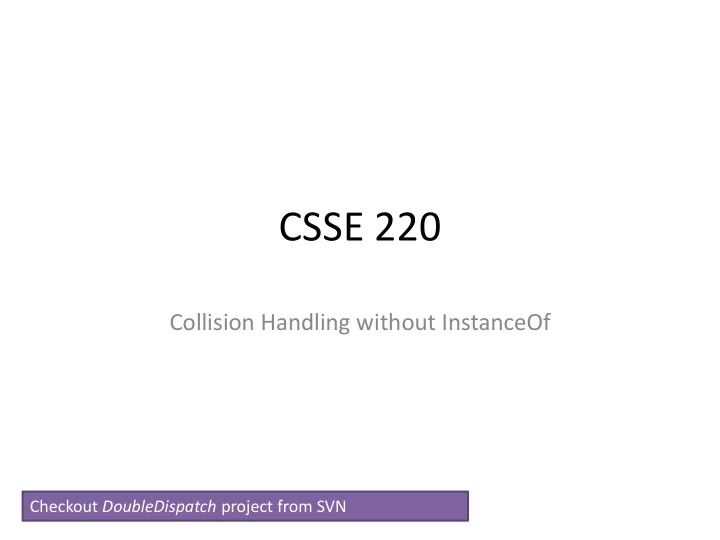

CSSE 220 Collision Handling without InstanceOf Checkout DoubleDispatch project from SVN
Important Hint • For ArcadeGame, you will need to figure out how to draw various things on the screen • Do this by having exactly 1 class that subclasses JComponent and invokes ordinary drawOn methods on all the other classes with the Graphics2D. That is, structured similarly to BallWorlds or BiggestFan. • Do NOT do this by having a whole bunch of subclasses of JComponent, all of which are added to a frame or panel. You will get updating problems.
InstanceOf • If you do inheritance correctly, you shouldn’t need instanceOf … – General guideline: rather than instanceOf, make a method in the class your instancing • If things get complicated we can use – Double Dispatch!
Bad Idea 1 // player has landed on o1 if(o1 instanceOf SpeedPowerUp) { // code to increase speed } if(o1 instanceOf LifePowerUp) { // code to increase life }
Same Bad Idea //player has landed on o1 if(o1.type().equals(“ SpeedPowerUp ”)) { //code to increase speed } if(o1.type().equals (“ LifePowerUp ”)) { //code to increase life }
Simple Solution o1.onPlayerCollision(player); // in SpeedPowerUpClass void onPlayerCollision(Player p) { // code to increase speed }
I think you can solve BomberMan just with this simple solution, and a few special cases abstract class GameObject { abstract boolean canBeMovedInto(); abstract void onBombDamage(); abstract void onPlayerCollision(..); … etc }
To Make The Simple Solution Work, you have to avoid arbitrary objects colliding with other objects • That simple solution worked because we knew one of the objects was the Player • What if we just have a big array of GameObjects, and sometimes GameObjects move into the same square with each other
Let’s say you have this class … public abstract class GameObject { public abstract void collide(GameObject m); public abstract void collide(Player m); public abstract void collide(PowerUp m); public abstract void collide(Monster m); }
Late-Binding with Params ? Uh oh… • So this code: GameObject m = getCollidedObject(); //We’ll say getCollidedObject() returned a PowerUp this.collide(m); • What method is called? – collide(GameObject powerup) • NOT collide(PowerUp powerup), even though the actual/instantiation type of m was PowerUp • Late-binding only works for the implicit argument (what becomes this – thing to the left of the dot), it doesn’t apply to parameter types.
This would work, but ew …. public abstract class Monster { public void collide(Monster m) { if (m instanceof Mushroom) { this.collide((Mushroom)m); return; Ew means } if (m instanceof Centipede) { Don’t Do This! this.collide((Centipede)m);return; } if (m instanceof Scorpion) { this.collide((Scorpion)m); return; } } public abstract void collide(Mushroom m); public abstract void collide(Centipede m); public abstract void collide(Scorpion m); }
Let’s try Double Dispatch… public abstract class GameObject { abstract void collide(GameObject m); abstract void collideWithPlayer(Player m); abstract void collideWithMonster(Monster m); abstract void collideWithPowerup(PowerUp m); }
Double Dispatch The key: You know your own type, so let’s say we’re in the PowerUp class, and GameObject is of type Monster: public class PowerUp extends GameObject { public void collide(GameObject m) { m.collideWithPowerUp( this); } public void collideWithPlayer(Player p) { //do specific action } } This will call the collideWithPowerUp method on the Monster class. Then in the Monster’s collideWithPowerUp class, add code for what should happen when a Monster collides with a PowerUp. See DoubleDispatch in repo
Work time Be sure everyone is getting a chance to drive. TEAM PROJECT
Recommend
More recommend